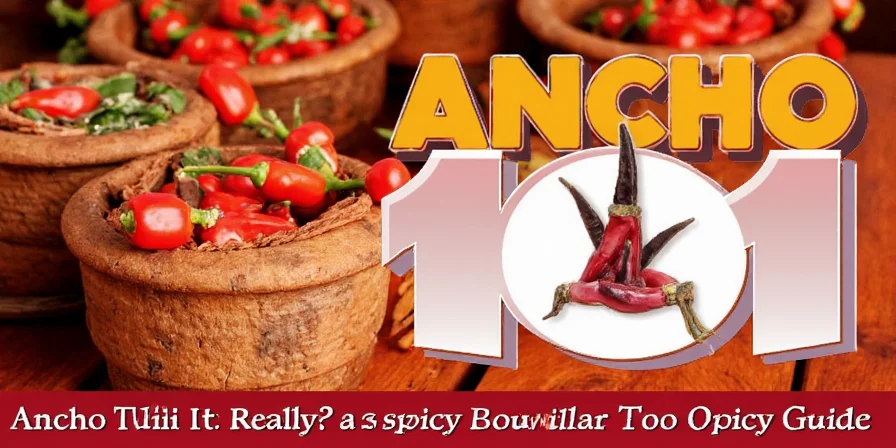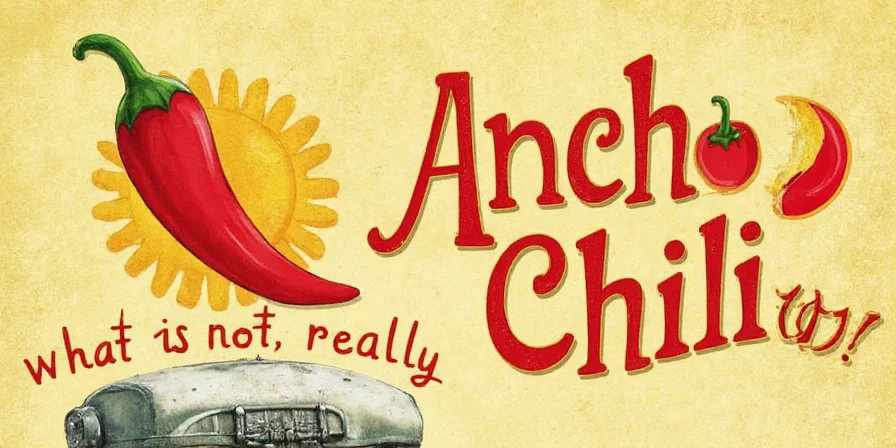Ancho Chili 101: What Is It, Really? A Spicy (But Not Too Spicy) Guide
So, you've been staring at the spice aisle trying to figure out what on earth an ancho chili is. You're not alone. Whether you're a home cook looking to level up your taco Tuesday or a culinary pro aiming for deeper flavor profiles, this guide has got you covered. Buckle up — we’re diving into the world of the ancho chili!
Table of Contents
- What Exactly Is an Ancho Chili?
- Heat Level: Scoville Scale Breakdown
- Flavor Profile: What Does It Taste Like?
- How to Use Ancho Chilies in Your Cooking
- Need a Substitute? Here Are Your Options
- Dried vs. Ground: Which Should You Buy?
- Pro Tips: Storing and Rehydrating Like a Boss
- Fun Facts You Probably Didn’t Know
- Final Thoughts
What Exactly Is an Ancho Chili?
You might be surprised to hear that the ancho chili isn't some mysterious alien pod from another planet — it's just the dried version of the Poblano pepper, which is native to Mexico. Yep, you read that right.

When Poblanos are left to ripen longer on the vine until they turn red, then picked and dried, they become anchos. The word “ancho” literally translates to “wide,” which makes sense once you get a look at its broad shape.
Heat Level: Scoville Scale Breakdown
Let’s talk heat. One of the most common questions people ask when exploring new spices is, “Is this going to make me cry?”
Luckily, ancho chilies fall on the milder side of the Scoville scale:
| Chili Variety | Scoville Heat Units (SHU) |
|---|---|
| Ancho Chili | 1,000 – 2,000 SHU |
| Jalapeño Pepper | 2,500 – 8,000 SHU |
| Habanero | 100,000 – 350,000 SHU |
| Ghost Pepper | Over 1,000,000 SHU |
So while ancho peppers can definitely bring some warmth to your dish, they won’t knock you off your feet like their fiery cousins. Perfect for those who want depth without the drama.
Flavor Profile: What Does It Taste Like?
If anchos were a wine, they’d be described as having “notes of raisin, plum, and earthy smokiness with hints of tobacco and coffee.” But since we’re talking about food, let’s keep it real — they have a deep, fruity, almost chocolate-like richness with subtle hints of sweetness and smoke.

Unlike jalapeños or serranos, which punch you with upfront heat, anchos give more of a slow-building warmth that enhances the overall flavor of dishes rather than dominating them.
How to Use Ancho Chilies in Your Cooking
Now that you know what anchos taste like, here are some delicious ways to put them to work in your kitchen:
- Mole sauces: Anchos are a staple in traditional mole poblano. They blend beautifully with chocolate, nuts, and spices to create that iconic rich sauce.
- Salsas & pastes: Roast, rehydrate, and puree anchos to make a deeply flavorful base for salsas or adobo pastes.
- Stews & soups: Toss a couple into simmering broths or stews for a background layer of heat and flavor.
- Dry rubs: Ground ancho powder adds complexity to barbecue rubs and marinades.
- Infused oils & spirits: Want to add a subtle kick to your homemade hot oil or chili-infused tequila? Ancho chilies are your best friend.
Need a Substitute? Here Are Your Options
We’ve all been there — you’re ready to make that killer enchilada recipe and realize you’re fresh out of anchos. Fear not! Here are some solid substitutes:
| Substitute | Pros | Cons |
|---|---|---|
| Guajillo Chili | Mild heat, similar flavor profile | Slightly less fruity |
| Chipotle Powder | Smoky and complex | Much hotter; use sparingly |
| Mulato Chili | Sweeter and darker in flavor | Harder to find |
| Pepperoncini | Mild and tangy | Not a good substitute for authenticity |
Keep in mind, none of these will taste exactly like an ancho, but they’ll help you salvage your dish in a pinch.
Dried vs. Ground: Which Should You Buy?
This is the age-old question when working with any chili. Let’s break down the pros and cons of each form:
| Form | Pros | Cons |
|---|---|---|
| Dried Whole | Better aroma and flavor retention | Takes time to rehydrate and prepare |
| Ground/Flakes | Convenient and easy to use | Flavor fades faster over time |
If you have time to soak and blend, go whole. If you're short on time or making something like chili dust or dry rub, ground ancho will do just fine.
Pro Tips: Storing and Rehydrating Like a Boss
Want your anchos to last longer and pack maximum flavor? Follow these simple steps:
- Storage: Keep dried anchos in an airtight container away from light and moisture. Stored properly, they can last up to a year.
- Rehydration: To bring back their soft texture and intensify flavor:
- Remove stems and seeds.
- Toast them in a dry skillet for 30 seconds per side (optional but recommended).
- Soak in warm water, broth, or even orange juice for 20–30 minutes until pliable.
- Drain and blend with soaking liquid for sauces or purees.
- Toasting tip: Toasting enhances the natural oils and brings out nutty, roasted flavors. Don’t skip this step unless you’re pressed for time!
Fun Facts You Probably Didn’t Know
Just because we’re serious about spice doesn’t mean we can’t have fun. Here are a few quirky facts about the ancho chili:
- The Poblano pepper comes from Puebla, Mexico — hence the name “Poblano.”
- When smoked and dried, a Poblano becomes a mulato chili, not an ancho.
- Anchos are one of the three key dried chilies used in authentic Mexican mole sauce.
- In Japan, ancho powder is sometimes used to season snack foods and ramen toppings.
- They pair surprisingly well with chocolate — don’t knock it till you’ve tried it!

Final Thoughts
So, to wrap it up: ancho chili is not just a spice, it’s a flavor enhancer, a culinary storyteller, and a gateway to authentic Mexican cuisine. Whether you’re tossing one into a stew or grinding it into a vibrant rub, this humble dried pepper punches way above its weight class in the flavor department.
Ready to take your spice game to the next level? Grab a few dried anchos from your local market or specialty store and start experimenting. Trust us — your tastiest days are ahead.











 浙公网安备
33010002000092号
浙公网安备
33010002000092号 浙B2-20120091-4
浙B2-20120091-4